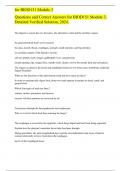for BIOD151 Module 3
Questions and Correct Answers for BIOD151 Module 3, Detailed Verified Solution, 2024.
The digestive system has two divisions: the alimentary canal and the auxiliary organs.
the gastrointestinal tract's seven sections
the anus, mouth, throat, esophagus, stomach, small intestine, and big intestine
six auxiliary organs of the digestive system
salivary glands, teeth, tongue, gallbladder, liver, and pancreas
mouth opening, lips, tongue floor, mouth walls, cheeks, roof of the mouth, hard and soft palates
The tongue is joined to the hyoid and mandibular bones by two bones and a membrane called the
lingual frenulum.
What are the functions of the adult human teeth and how many are there?
In order to mechanically digest food, thirty-two teeth operate in tandem to shred, crush, and ground food.
Which four types of teeth are there?
canines, molars, premolars, and incisors
incisors All three portions are traversed by air.
Food passes through the laryngopharynx and oropharynx.
Why is it vital to block food from entering the lungs?
The esophagus is covered by the epiglottis, which keeps liquid and food from being aspirated.
Explain how the pharynx's muscular layers help food pass through.
During peristalsis, the inner longitudinal layer and the circumferential outer layer of muscle contract alternately to force food down the esophagus.
layers of the esophageal tissue for BIOD151 Module 3
The third layer is the muscularis externa, which is composed of two layers of muscle: the outermost layer is the mucosa, which secretes mucus into the interior of the gastrointestinal tract;
the second layer is the submucosa, which contains blood and lymph vessels, lymph nodes, nerves, and mucous glands; and the third layer is the mucosa. air travels through all three sections
food travels through oropharynx and laryngopharynx
What prevents food from entering the lungs and why is this necessary?
The epiglottis covers the esophagus and prevent aspiration of food and liquid.
Describe how the muscular layers in the pharynx assist with food passage.
The two layers of muscle, circumferential outer layer and inner longitudinal layer, alternatively contract to squeeze the food into the esophagus by peristalsis.
Tissue layers of the esophagus
the innermost layer is the mucosa which secretes mucus into the interior the gastrointestinal tract,
the second layer is the submucosa which contains blood and lymph vessels, lymph nodes, nerves,
and mucous glands, the third layer is the muscularis externa which is made of two layers of muscle: the outer longitudinal fibers and inner circumferential fibers and the outermost layer is the serosa which is made up of cells that make serous fluid.
Peristalsis
the squeezing of food through the GI tract by the alternating contraction of the sets of longitudinal and circumferential muscles.
three main divisions of the tooth
crown, neck, root
three types of papillae
filiform, fungiform, circumvallate
Which papillae contain taste buds
Circumvallate and fungiform
Describe the shape of the stomach and its location relative to the abdomen and diaphragm.
stomach is a backward C-shaped organ located along the left side of the abdomen and below the diaphragm
Describe the passage of food into and out of the stomach
Food enters from the esophagus via the cardioesophageal sphincter and exits the stomach via the pyloric sphincter into the small intestine
lesser curvature
concave, extends inward on the shorter side of the stomach
greater curvature
convex, extends outward on the shorter side of the stomach
lesser omentum
serous membrane that attaches lesser curvature to the liver
greater omentum
serous membrane which attaches greater curvature to the posterior wall of the body
two functions of the stomach
1. Temporary storage area for food, storing up to two liters of partially digested food.
2. The muscular walls of the stomach contract vigorously and mix food with juices that are secreted when food enters the stomach, allowing food to be broken down into smaller pieces.
The pH of stomach is 1.3 - 3.5. What is this due to and what is its source and function?




